Oral - Power Pitch Session
RF Technologies
Session Topic: RF technologies
Session Sub-Topic: RF Components & Coils
Oral - Power Pitch
Engineering
| Wednesday Parallel 5 Live Q&A | Wednesday, 12 August 2020, 13:45 - 14:30 UTC | Moderator: Boris Keil |
Session Number: PP-31
0745.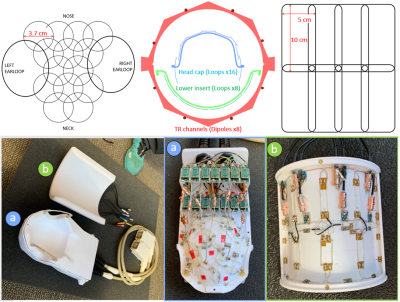 |
An 8-CH Dipole Transceiver Array with 24-CH Loop Receiver Array for Non-Human Primate Head Imaging at 10.5T
Russell Luke Lagore1, Steen Moeller1, Lance DelaBarre1, Andrea Grant1, Jerahmie Radder1, Kamil Ugurbil1, Essa Yacoub1, Noam Harel1, and Gregor Adriany1
1Center for Magnetic Resonance Research, University of Minnesota, Minneapolis, MN, United States
In this work we developed an 8-CH dipole transceive with 24-channel loop receive array (for a total of 32 receive channels) for head imaging of anesthetized non-human primates at 10.5T. We demonstrate the benefits of receiving with both the dipole array and loop arrays to recapture SNR in deep brain structures and allow for accelerated acquisitions with near lossless parallel imaging performance up to R=3 in either AP or LR. Presented are diffusion and anatomical MR images acquired with this coil.
|
|
0746.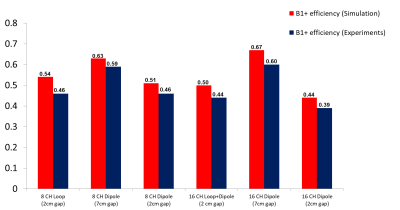 |
Effect of Coaxial Feed Cables on the Performance of Loop & Dipole Arrays at Ultra High Frequencies
Myung Kyun Woo1, Lance DelaBarre1, Russell Lagore1, Andrea Grant1, Steve Jungst1, Yigitcan Eryaman1, Kamil Ugurbil1, and Gregor Adriany1
1Center for Magnetic Resonance Research, Minneapolis, MN, United States
We designed and built three elliptically arranged 8- and 16-channel transceiver dipole and loop arrays for the human head applications and evaluated the influence of coaxial feed cables on the overall array performance. The influence of coaxial feed cables was evaluated in simulation and compared against actual built arrays in terms of B1+ and SAR efficiency. For all three arrays we consistently observed ~30 % performance reduction compared to the “ideal” coil with no coaxial cables.
|
|
0747.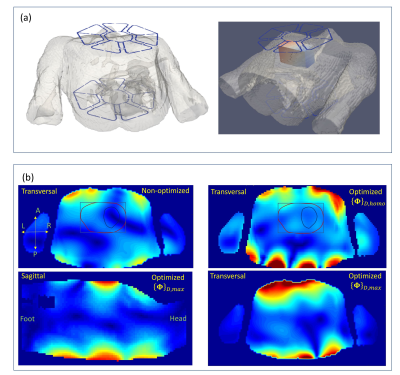 |
Customized B1+-Shaping using Multi-Channel Transceiver Array Prototype for 7T Cardiac MRI with Central Elements Symmetry
Maxim Terekhov1, Ibrahim A. Elabyad1, Frank Resmer2, Titus Lanz2, Theresa Reiter1,3, David Lohr1, Wiebke Schlöttelburg1,4, and Laura M. Schreiber1
1Chair of Cellular and Molecular Imaging, Comprehensive Heart Failure Center (CHFC), University Hospital Würzburg, Wuerzburg, Germany, 2RAPID Biomedical, Rimpar, Germany, 3Department of Internal Medicine l, University Hospital Wuerzburg, Wuerzburg, Germany, 4Institute of Diagnostic and Interventional Radiology, University Hospital Wuerzburg, Wuerzburg, Germany
Multiple element transmits and receive (mTx) phased arrays allow for improvement of the image quality in ultra-high-field (B0≥7T) cardiac MRI (cMRI). The optimization performed for both transmit and receive requires novel approaches regarding mTx element geometry and positioning making а B1-shimming of such arrays a complicated problem. We have demonstrated the initial experience of the case-specific B1-shimming of the mTX-array design for cMRI at 7T. The design with a central symmetry of elements and tailored cost function used for driving phases optimization allows for high flexibility in shaping of predefined target B1+ profiles.
|
|
0748.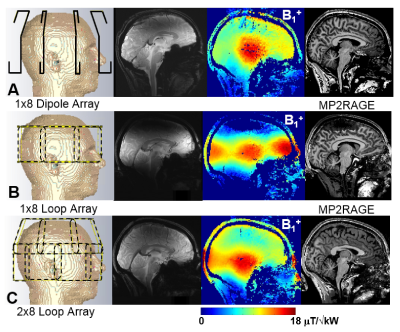 |
Asymmetric Dipole Head Array for Ultra-High-Field Magnetic Resonance Imaging Turns “Dielectric Resonance” from an Enemy to a Friend.
Nikolai Avdievich1, Georgiy Solomakha2, Loreen Ruhm1, Jonas Bause1,3, Anke Henning1,4, and Klaus Scheffler1,5
1Max Planck Institute for Bilogical Cybernetics, Tuebingen, Germany, 2Nanophotonics and Metamaterials, ITMO University, St.Petersburg, Russian Federation, 3Graduate School of Neural and Behavioral Sciences, Tuebingen, Germany, 4Advanced Imaging Research Center, University of Texas Southwestern Medical Center, Dallas, TX, United States, 5Department for Biomedical Magnetic Resonance, University of Tübingen, Tuebingen, Germany
We developed a novel 9.4T (400MHz) human head transceiver array consisted of 8 optimized bent folded dipole antennas. Due to an asymmetrical shape of dipoles (bending) and the RF shield, the array simultaneously excites two modes including a circular polarized mode of the array itself, and the TE mode of the human head. Mode mixing can be easily controlled by changing the folded length. As a result, the new array provides superior whole-brain coverage compared to various 8-element loop and dipole arrays or even to a more complicated 16-element loop array. In addition, the maximum local SAR is substantially reduced.
|
|
0749.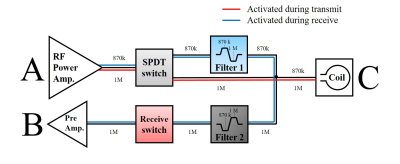 |
Design of frequency division duplex RF system for frequency encoding using Bloch-Siegert shift
Yonghyun Ha1, Kartiga Selvaganesan1, Charles Rogers III1, Baosong Wu1, Sajad Hosseinnezhadian1, Gigi Galiana1, and R. Todd Constable1
1Department of Radiology and Biomedical Imaging, Yale School of Medicine, New Haven, CT, United States
In this work, we designed a frequency division duplex RF system for frequency encoding using Bloch-Siegert shift at very low field, with a modification of dual-band pass filters. Although the off-resonance frequency (870 kHz) is very close to the Larmor frequency (1 MHz), the applied off-resonance signal can be filtered out by a modified dual-band pass filter on the receive path. This system allows us to apply a 870 kHz transmit pulse while receiving 1 MHz signal from the RF coil.
|
|
0750.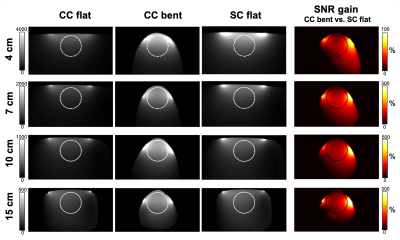 |
Flexible receive-only coaxial coils with multiple turns and gaps for 3 T MRI
Lena Nohava1,2, Raphaela Czerny2, Michael Obermann1,2, Jacques Felblinger3, Roberta Frass-Kriegl2, Jean-Christophe Ginefri1, and Elmar Laistler2
1IR4M (Imagerie par Résonance Magnétique et Multi-Modalités), UMR8081, Université Paris-Sud/CNRS, Université Paris-Saclay, Orsay, France, 2Division MR Physics, Center for Medical Physics and Biomedical Engineering, Medical University of Vienna, Vienna, Austria, 3Université de Lorraine, Inserm, IADI, Nancy, France
A bench and 3 T MRI study of flexible multi-turn multi-gap coaxial coils and standard copper wire coils with 4, 7, 10 and 15 cm loop diameter is presented. The coaxial coils are made of four different cable types and can be employed for different biomedical applications where form-fitting the coil to the subject anatomy is advantageous. We evaluate the receive-only coaxial coils’ active detuning performance, their robustness upon bending and demonstrate a significant SNR gain when using bent coaxial coils instead of flat standard coils.
|
|
0751.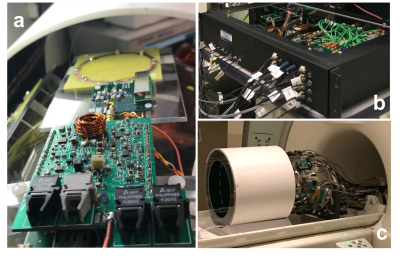 |
Practical eight-channel pTx system for 7 T MRI with optically controlled and monitored on-coil current-source RF amplifiers
Natalia Gudino1, Jacco A de Zwart1, and Jeff H Duyn1
1LFMI, NINDS, National Institutes of Health, Bethesda, MD, United States
We present an eight channel pTx-Rx system built with optically controlled and monitored on-coil Tx amplifiers and optical pTx control optimized for 7 T imaging. We show preliminary results of the technology implemented for human head imaging.
|
|
0752.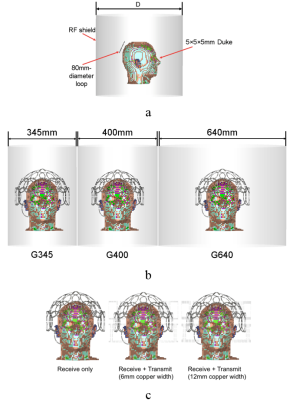 |
Shielding Effects on Signal-to-Noise Ratio at Ultra-High Field MRI
Bei Zhang1,2, Gregor Adriany3, Andrea Grant3, Russell Lagore3, Brian Rutt4, Kamil Ugurbil3, and Riccardo Lattanzi1,5
1Center for Advanced Imaging Innovation and Research, New York University School of Medicine, New York, NY, United States, 2Advanced Imaging Research Center, University of Texas Southwestern Medical Center, Dallas, TX, United States, 3Center for Magnetic Resonance Research, University of Minnesota, Minneapolis, MN, United States, 4Stanford University, Stanford, CA, United States, 5The Sackler Institute of Graduate Biomedical Sciences, New York University School of Medicine, New York, NY, United States
We evaluated the effect of a radio frequency shield on the signal-to-noise ratio (SNR) of a loop coil at various field strengths in simulation. At 7T, SNR constantly improves as the shield diameter increases. At higher field strengths, SNR is maximized when using an optimal shield diameter, which is inversely proportional to the frequency. We also show that central SNR for a 32-channel receive array could drop by a factor of two when using a non-optimal shield diameter at 10.5T. Inserting a transmit array between the receiver and an optimally-sized shield could considerably deteriorate SNR.
|
|
0753.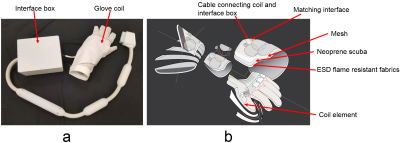 |
A 22-channel high impedance glove array for dynamic hand and wrist imaging at 3T
Bei Zhang1,2, Justin Ho1, Shota Hodono1,3, Bili Wang1, Ryan Brown1,3, Riccardo Lattanzi1,3, Markus Vester4, Robert Rehner4, and Martijn Cloos1,3
1Center for Advanced Imaging Innovation and Research, New York University School of Medicine, New York, NY, United States, 2Advanced Imaging Research Center, University of Texas Southwestern Medical Center, Dallas, TX, United States, 3The Sackler Institute of Graduate Biomedical Sciences, New York University School of Medicine, New York, NY, United States, 4Siemens Healthcare, Erlangen, Germany
We constructed a 22-channel high impedance glove array for dynamic hand and wrist imaging. The glove array has a robust, flexible, comfortable, safe, and cleanable construction. Siemens Tim4G technology was used to connect coils to the scanner through a single bundled cable to streamline the workflow and permit hand postures that are uninhibited by bulky components. Compared to a rigid commercial 16-channel Hand/Wrist coil, our 22-channel glove array showed higher SNR on fingers and wrist and comparable SNR on the palm and top of the hand. Further analysis revealed low coupling between the coils that resulted in good acceleration performance.
|
|
0754.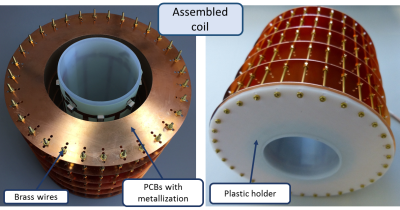 |
Experimental Characterization of Artificial Magnetic Shield for Improvement of Small-Animal Birdcage at 7 T
Ksenia Lezhennikova1, Redha Abdeddaim2, Anna Hurshkainen1, Alexandre Vignaud3, Marc Dubois2,4, Konstantin Simovski5, Alexander Raaijmakers6, Irina Melchakova1, Stefan Enoch2, Pavel Belov1, and Stanislav Glybovski1
1Faculty of Physics and Engineering, ITMO University, St.Petersburg, Russian Federation, 2CNRS, Centrale Marseille, Institut Fresnel, Aix Marseille Univ, Marseille, France, 3CEA-Saclay, DRF/I2BM/Neurospin/UNIR, Université Paris-Saclay, Gif-sur-Yvette Cedex, Paris, France, 4CNRS, CRMBM, Aix Marseille Univ, Marseille, France, 5Department of Electronics and Nanoengineerin, AALTO University, AALTO, Finland, 6Biomedical Engineering, Eindhoven University of Technology, Eindhoven, Netherlands
We proposed a practical realization of an artificial shield for a small-animal birdcage coil for 7T MRI based on a cylindrical miniaturized corrugated structure, which demonstrates the property of a constructive interference inside the coil. The presence of a conventional metallic shield around the birdcage significantly limits the coil efficiency because of the destructive interference between the magnetic field of the shield and the primary field of the coil in the subject. We numerically and experimentally demonstrated that the proposed structure placed around the birdcage could increase the efficiency for relatively small samples due to its in-phase reflection.
|
|
0755.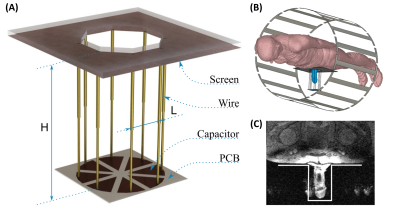 |
A novel RF-resonator for penile imaging
Evgeniy Alekseevich Koreshin1, Mikhail Zubkov1, Alexander Yurievich Efimtcev2, Alexandr Mikhailovich Gulko3, and Irina Valerievna Melchakova1
1Faculty of Physics and Engineering, ITMO University, Saint-Petersburg, Russian Federation, 2Department of Radiology, Federal Almazov North‐West Medical Research Center, Saint-Petersburg, Russian Federation, 31st urology department, City Center of Endourology and New Technologies, Saint-Petersburg, Russian Federation
We present a new design of a radiofrequency resonator for urological applications. The resonator functions by inductively coupling to the body coil of a 1.5 T MR-scanner. This configuration of the Tx-Rx path allows increasing the transmission efficiency and signal to noise ratio (SNR) while reducing the specific absorption rate (SAR). Phantom and in-vivo imaging shows that the resonator provides around 100-fold SAR reduction and 10-fold transmission efficiency increase. Phantom imaging shows doubled SNR compared to the commercial flexible 4-element Rx coil. In-vivo imaging shows only a 50% increase in SNR, improved patient positioning and reduced the artifacts rate.
|
|
0756.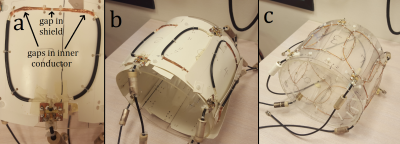 |
High impedance coils versus conventional loop coils for transmit purposes: a comparison using an eight channel head coil array for 7 Tesla
Carel Costijn van Leeuwen1, Masoud Mazraeh Mollaei Sharifian2, Luca van Dijk1, Konstantin Simovski2, and Alexander J. E. Raaijmakers1,3
1Department of radiology, University Medical Center Utrecht, Utrecht, Netherlands, 2Aalto University, Espoo, Finland, 3Biomedical Engineering, Eindhoven University of Technology, Eindhoven, Netherlands
This study compares high impedance coils to conventional loop coils for transmit purposes at 7 Tesla. A new design for high impedance coils is presented. Two eight-channel head arrays of equal dimensions were created; one using high impedance coils, one with conventional loops. B1 field maps are produced to compare transmit efficiency. Scattering parameters are measured in various loading conditions to compare inter-element coupling. The high impedance coils perform worse in terms of transmit efficiency, and better in terms of coupling.
|
|
0757. |
Optimization of a close-fitting volume RF coil using linear programming for brain imaging at 6.5 mT
Sheng Shen1,2, Zheng Xu1, Neha Koonjoo2,3,4, and Matthew S. Rosen2,3,4
1State Key Laboratory of Power Transmission Equipment and System Security and New Technology, Chongqing University, Chongqing, China, 2MGH/A.A. Martinos Center for Biomedical Imaging, Cambridge, MA, United States, 3Department of Physics, Harvard University, Cambridge, MA, United States, 4Harvard Medical School, Boston, MA, United States
The use of a close-fitting roughly head-shaped volume coil for MRI has the merit of improving the SNR from the brain. However, the surface of the RF coil follows that of the head, making it difficult to determine the optimal coil winding pattern. Here, we proposed a method which combines finite element method simulation and linear programing to optimize the coil pattern of a close-fitted RF coil with the objective of maximizing its SNR and RF-magnetic-field homogeneity for operation at ultra-low field (6.5 mT, 276 kHz). We then tested the optimized coil by imaging a water-filled phantom using a 3D-bSFFP.
|
|
0758.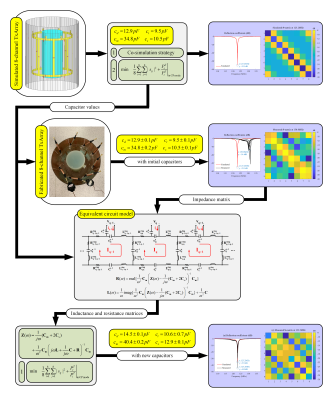 |
Design of an 8-channel transmit array coil using the equivalent circuit model of the manufactured structure
Ehsan Kazemivalipour1,2, Alireza Sadeghi-Tarakameh1,2, Ugur Yilmaz2, and Ergin Atalar1,2
1Electrical and Electronics Engineering Department, Bilkent University, Ankara, Turkey, 2National Magnetic Resonance Research Center (UMRAM), Bilkent University, Ankara, Turkey
We propose a practical approach to designing transmit array (TxArray) precisely by integrating the equivalent circuit model of the manufactured structure and its EM simulation results to reduce the measurements and simulations differences caused by the imperfection in manufacturing. We investigate the performance of a shielded 8-channel degenerate birdcage head TxArray at 123.2MHz together with simulation and experiment to validate the proposed method. All self/mutual-inductances and self/mutual-resistances of the manufactured TxArray have been computed to determine the optimum capacitor values by minimization of the total return power from the coil.
|
|
0759. |
BPSK/ASK Wireless Link Assessment for MRI
Greig Cameron Scott1, Shreyas Vasanawala2, Fraser Robb3, and John Pauly2
1Electrical Engineering, Stanford University, Stanford, CA, United States, 2Stanford University, Stanford, CA, United States, 3GE Healthcare, Aurora, OH, United States
We assess the use of binary phase shift keyed and amplitude shift keyed modulation to develop a very short range wireless link. Here the signal integrity for transmission of 200 Mbps at 3.2 GHz carrier frequencies were demonstrated in a mock MRI bore environment. This approach provides a viable path for wireless MRI receive coil data transfer.
|

 Back to Program-at-a-Glance
Back to Program-at-a-Glance Watch the Video
Watch the Video Back to Top
Back to Top